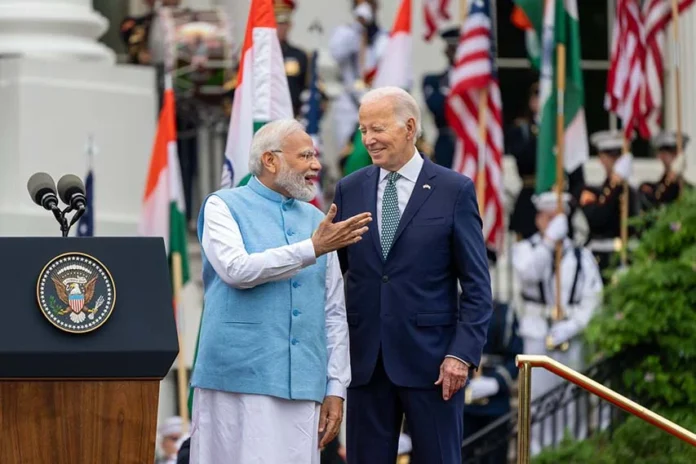The visit, in essence, was born out of realism created in the wake of Russia’s invasion of Ukraine and China’s aggressive behaviour in the Indo-Pacific region. A concern in this regard resonated across the bilateral talks between Prime Minister Modi and President Joe Biden in the White House and PM Modi’s speech at the US Congress on June 22.
Without taking China’s name, the visiting Indian Prime Minister, who got a rare opportunity to address a joint session of the US Congress twice – first, in June 2016 and second, in June this year – expressed his worries over Beijing’s belligerent approach in the Indo-Pacific region. He said “The dark clouds of coercion and confrontation are casting their shadow in the Indo-Pacific. The stability of the region has become one of the central concerns of our partnership.”
This may have rattled China, but what could have given it a sleepless night was India-US bonhomie across all spectrums of bilateral engagement, including partnership in the area of critical technology. For the first time, the US has agreed to provide India technologies that it usually keeps for its personal use or gives to closest allies like the UK and other European allies, Japan, and South Korea on conditions.
Launch of the Initiative on Critical and Emerging Technology (iCET) in January 2023, in this regard proved as a major milestone since it led to fostering an “open, accessible, and secure technology ecosystem,” between the two countries. It was seen when India and the US entered into partnership in 25 areas of technology. This found a clear mention in the joint statement issued after Prime Minister Modi and President Biden talks in the White House.
In the space sector, ISRO and NASA have agreed to develop a strategic framework for human spaceflight cooperation by the end of 2023.
Besides, NASA will provide advanced training to Indian astronauts at the Johnson Space Centre in Houston, Texas with an aim to undertake a joint mission to the International Space Station (ISS) in 2024. Currently, the ISS is populated by astronauts from the US, Russia, Canada, Japan, and the European Union. Astronauts from Israel, UAE and Saudi Arabia have also worked at the ISS.
In a clear departure from its past technology denial regime, the US has agreed to enhance commercial collaboration with India’s private sectors in the entire value chain of the space economy; it has also agreed to address export controls and facilitate technology transfer, a move which will revolutionise the space industry in India. India has also joined the Artemis Accords, a non-binding treaty which has been signed by 26 countries for space exploration of the moon, Mars and beyond.
Ensuring that sky is not limit when it comes to collaboration between the two countries in the area of advanced technology, the two sides have agreed to promote policies and adapt regulations that facilitate greater technology sharing, co-development and co-production between Indian and US industry, government and academic institutions.
But it has been in the area of semiconductor technology that the two countries want to open a new chapter and it has been seen when New Delhi and Washington DC signed an MoU on semiconductor supply chain and innovation partnership—viewed as a significant step in the coordination of semiconductor incentive programmes.
While the US and its allies are making all bids to deny China access to critical technology required for semiconductor manufacturing, America has decided to promote commercial opportunities, encourage research and facilitate training of Indian engineers for the chip making industry. Micron Technology Inc has decided to invest up to $825 million to build a new semiconductor assembly and test facility in India with support from the Indian government.
Giving more clarity over investment in semiconductor industry, Foreign Secretary Vinay Mohan Kwatra said, “Whether it is the decision of Micron to set up an assembly line and test facility in India with a total investment amounting to roughly $2.75 billion, of course, it would have a large chunk from Micron, but there will be other investors too.”
On the skilling and training front, Foreign Secretary Kwatra said Lam Research, an American supplier of wafer-fabrication equipment and related services to the semiconductor industry, will train 60,000 Indian engineers. He said the American company will invest $400 million to establish a collaborative engineering centre in India.
In Quantum science, the two countries will work for the joint development and commercialisation of Artificial Intelligence and quantum technologies and agreed to encourage public-private collaboration to develop high performance computing facilities in India. The US has also agreed to do its best in supporting the joining of India’s Centre for Development of Advanced Computing (C-DAC) with the US Accelerated Data Analytics and Computing (ADAC) Institute.
Under the bilateral framework of “Trusted Network/Trusted Sources,” Prime Minister Modi and President Biden launched two Joint Task Forces on advanced telecommunications, focused on open RAN and research and development in 5G/6G technologies.
India and the US have decided to collaborate in 35 innovative research areas, especially in emerging technologies, while working to generate fresh funds for joint projects in applied research areas such as semiconductor, next generation communication, cyber security, sustainability, green technologies and intelligent transportation systems.
Next to technology, it was India-US partnership in advanced defence technology and its transfer dominated the talks between Prime Minister Modi and President Biden. As India’s HAL and US’s General Electric signed a deal for manufacturing GE F-414 jet engines for LCAMk2, New Delhi set its eyes on procuring MQ-9B SeaGuardian drones from General Atomics.
Reuters quoted sources as saying that India will buy 31 drones made by General Atomics worth slightly over $3 billion. General Atomics will set up a Comprehensive Global MRO facility in India to support its long-term goals of boosting indigenous defence capabilities.
Both countries have also agreed to work together for the creation of logistic, repair, and maintenance infrastructure for aircrafts and vessels in India.
Yet what made Prime Minister Modi’s state visit spectacular was its impact in making India-US defence partnership special. A glimpse of it can also be seen in the India-US Defence Acceleration Ecosystem (INDUS-X). It will facilitate joint defence technology innovation and co-production of advanced defence technology between the respective industries of the two countries.
“The US Department of Defense’s Space Force has signed its first International Cooperative Research and Development Agreement with Indian start-up 114 AI and 3rdiTech. Both companies will work with General Atomics to co-develop components using cutting edge technologies in AI and semiconductors respectively,” said the India-US Joint Statement.
In nutshell, PM Modi’s state visit remained successful in transporting the India-US relations to a high-level in the field of critical and defence technologies, it also remained successful in enhancing trade relationship, strategic partnership and boosting engagement in the areas of energy and health.
–The writer is a senior journalist with wide experience in covering international affairs. The views expressed are of the writer and do not necessarily reflect the views of Raksha Anirveda
–The writer is a senior journalist with wide experience in covering international affairs. The views expressed are of the writer and do not necessarily reflect the views of Raksha Anirveda






